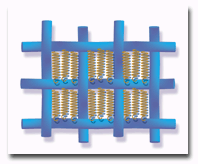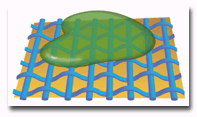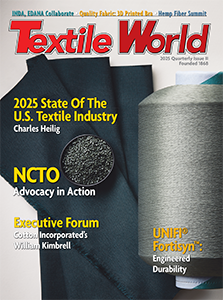Swift Spinning Mills Reorganizes Resources Swift Spinning-Tifton Inc., the Tifton, Ga., operation
of Columbus, Ga.-based Swift Spinning Mills Inc. will close its doors on March 29, 2001. Officials
noted that they will make every effort to sell the operation as an ongoing concern. The decision
was made to close the plant after it was decided that the best way to utilize the companys existing
resources to meet customer needs was to consolidate operating units back into Swift Spinnings
Columbus operations.Shiro Kobayashi, chairman and CEO, said, Our intentions are to find a buyer for
the operation, and hopefully the new owner will maintain the current workforce. In the event we are
unable to sell the plant, we will make every effort to help these people as they transition into
other jobs in the Tifton area. We find it necessary to make this move in an effort to improve our
competitive position in the textile industry.Approximately 110 people will be impacted by the
plants closure.
March 2001
Swift Spinning Mills Reorganizes Resources
2001 Beltwide Cotton Conference Brighter Future
2001 Beltwide Cotton Conference: Brighter Future Memphis cotton merchant William B. Dunavant Jr.
told 2001 Beltwide Cotton Production Conference attendees in Anaheim, Calif., that cotton
production for the year 2000 will be about 17.2 million bales, compared with 16.6 million in 1999.
He added, however, that both years were disasterous with respect to quality and yield.For
2001-2002, Dunavant projected U.S. domestic consumption of 9.9 million bales and exports of at
least 8.3 million bales, as the Caribbean Basin Initiative (CBI) kicks in. The cotton industry has
struggled the last three years, but I truly believe that our future today is brighter than it has
been in a number of years, he said.He said the U.S. textile industry will be fortunate to consume
9.7 million bales in 2000, compared with the U.S. Department of Agricultures (USDA) projected 9.8
million. He projected exports between 7 million and 7.3 million bales, with a substantial increase
in exports from February forward.Dunavant said major buyers of world cotton have changed
dramatically because of the shift in the textile industry from developed to developing
countries.What we see is Mexico, Brazil, China, Bangladesh, Vietnam, Russia and Turkey expanding
their cotton consumption, and the major traditional consumers like Japan, Korea, Taiwan and Hong
Kong losing their textile industries, Dunavant said. He added that he doesnt see China as a major
exporter this season because there is inadequate supply for export of high-quality cotton and
because its domestic industry requires this cotton.Robert McLendon, National Cotton Council (NCC)
president, told conference attendees that the NCC is devoting considerable resources to technology
advances, including efforts to improve cotton yield and quality. Efforts are necessary because a
combination of yield and quality losses has wrung most of the profits out of cotton production in
recent years, and world prices continue to languish below production costs, he said.McLendons
report described NCC-supported yield and quality objectives that he said are fundamental to
improving the U.S. cotton industrys profitability and maintaining its competitive edge.
March 2001
Como Textile Printers Installs Arioli Steamer
Como Textile Printers, Paterson, N.J., recently installed a New Generation Steamer from Italy-based
Arioli. The new steamer replaces an older mini-steamer and is the fourth Arioli steamer to be
purchased by Como.Como selected the steamer because, using the same manpower, the new steamer can
accomplish four times the production of the old mini-steamer.The New Generation Steamer uses a
differential steam-distribution method. The steam distributed in the chamber does not have to be
uniform, but must be concentrated at the front of the machine. The exothermic reaction from the
dyestuff fixation and urea dissociation takes only a dozen seconds, and it is logical to
concentrate the fresh steam flow where these two vital phenomena take place. A special
steam-injection duct at the front of the machine concentrates 70 percent of the total steam flow,
which is pretreated and conditioned prior to entry.The steamer is equipped with programmable
controls that operate and monitor the speed of the recalculating and exhaust fans, the selvage
expanders, the fabric loop length, dwell time, production, temperature and steam flow, as well as
the working modes, which include saturated, superheated, hot-air and cooling.The steamer
supervisory system has images for the machine settings, temperature graphics, steam flow, trouble
shooting and recording of print recipes. All parameters and graphics can be stored and recalled at
any time.
March 2001
Great American Knitting Mills Completes Ridgeview Inc Transaction
BURLINGTON, N.C., Feb 23 /PRNewswire/ — On Wednesday, February 21, 2001Great American Knitting
Mills successfully completed the previously announced asset purchase of Ridgeview, Inc. For GAKM,
the components of the deal include the purchase of certain inventory, intangible assets and
intellectual properties. To guarantee uninterrupted service to Ridgeview’s customers, GAKM will
continue to operate certain Ridgeview facilities for a period of time. During this time, a
transition team established by GAKM will manage the consolidation of manufacturing, administrative,
customer service, and distribution operations into GAKM’s systems. Hugh Gaither will resign his
current position as CEO of Ridgeview but will be a member of the transition team to insure
Ridgeview’s customers continue to be fully serviced. Both Gaither and Jim Williams, CEO of GAKM,
said they “are pleased that the deal has been successfully completed and their immediate focus is
on a seamless transition of the business.” Additionally, Williams said, “this asset purchase
complements GAKM’s already strong portfolio of brands,including GOLD TOE(R), Silver Toe(R), GOLD
TOE Gear(TM), and will accelerate the company’s planned expansion into the sporting goods market.”
Great American Knitting Mills, founded in 1919, is based in Burlington,North Carolina, with
manufacturing facilities in Newton, North Carolina and Bally, Pennsylvania. GOLD TOE(R), GOLD TOE
Gear(TM), and Silver Toe(R) are trademarks of Great American Knitting Mills.SOURCE Great American
Knitting MillsWeb Site: http://www.thefashion.orgCopyright 2001 PR Newswire
Gretchen Bellinger Introduces New Fabrics
Gretchen Bellinger Inc., Cohoes, N.Y., has introduced three new interiors fabrics. Cashmere is a
100-percent cashmere brushed-twill fabric available in black. The fabric can be used as wall
covering.Woven of 54-percent wool and 34-percent cotton, In a Twinkling is a plush wool/pile blend
fabric with a hint of sparkle. The fabric is custom-dyed in The Netherlands and is available in a
range of colors.The third introduction is called Velvet Underground. This fabric is a dual-tone
mohair velvet of contrasting base and pile colors. Bellinger states that the fabric is sturdy and
well-suited for residential, contract and hospitality applications.
March 2001
Carpet Magnate Ray Anderson Wins Environmental Prize
Ray C. Anderson has been named the recipient of the 2001 George and Cynthia Mitchell International
Prize for Sustainable Development. Anderson, a Georgia Institute of Technology graduate, is the
founder and chairman of Atlanta-based carpet manufacturer Interface Inc.Anderson declared war on
waste in products and processes at his commercial carpet company and was chosen for the award
because he is an individual in the corporate setting who has made corporate sustainable development
activities possible. The prize was established by Houston businessman and philanthropist George P.
Mitchell and his wife, Cynthia, to recognize outstanding contributions to sustainable development.
Anderson was presented with the award at the Woodlands Conference organized by the Houston Advanced
Research Center. This is only the seventh time since 1974 that the prize has been awarded. Ray
Anderson is a pioneer in using innovative approaches to change past practices and to eliminate
waste, said Mitchell. His vision of how sustainable technology can be used as a core principle in
doing business is exemplary.Anderson instituted an innovative program to transform Interface first
by making it a sustainable company in all practices and eventually to make it a restorative company
one that returns to the earth more than it takes. Interface has undertaken more than 400
sustainability initiatives, including the design of new carpets and fabrics that are 100-percent
recyclable at the end of their use.
March 2001
Dystar Introduces Two New Dyes
Germany-based Dystar has added two new dyes to its Remazol® reactive dye range.The main application
of Remazol Orange BN is the shading of black, dark bordeaux and brown hues on cellulosic fibers. It
can also be used for the dyeing of bronze shades, as well as pale to medium shades of brown. Orange
BN is a dischargeable vinyl sulphone dye and is compatible with all other Remazol dyes.Remazol Red
FLM is a dischargeable red dye that is metal- and AOX-free. The dye is suitable for cold pad-batch
and continuous dyeing of cellulosics.
March 2001
Quality Fabric Of The Month: Like Water Rolling Off A Duck’s Back
Greensboro, N.C.-based Galey & Lord Inc. is using new cutting-edge technology to give its cotton fabrics permanent water repellence and stain and wrinkle resistance. The venerable fabric manufacturer has recently been licensed to use technology developed by Nano-Tex LLC, also based in Greensboro, in its fabrics for the bottomswear market
(See K/A News, ATI, February 2001). Nano-Tex, a privately held research company with majority ownership by Burlington Industries Inc., Burlington, N.C., develops nanotechnology for use in textiles. By means of polymer chemistry applications, nanoparticles are permanently attached to cotton or synthetic fibers. The change occurs at the molecular level, and the particles can be configured to imbue the fabric with various attributes.
“Nanotechnology combines the performance characteristics associated with synthetics with the hand and feel of cotton,” said Delores Sides, director of corporate communications, Burlington. She cited its application for everyday fabrics used in business and casual wear.


Through Nano-Care technology, nano-whiskers are attached to individual cotton fibers. The
whiskers cause liquids to roll off the fabric.
Nano-Care™ For Cotton
Through Nano-Tex’s Nano-Care™ technology for cotton, “nano whiskers” 1/1000 the size of a typical cotton fiber are attached to the individual fibers. The changes to the fibers are undetectable and do not affect the natural hand and breathability of the fabric. The whiskers cause liquids to roll off the fabric. Semi-solids such as ketchup or salad dressing sit on the surface, are easily lifted off and cause minimal staining, which should be removed with laundering.
The attributes provided by Nano-Care have traditionally been added by the use of coatings, which affect the fabric’s inherent qualities, or by other treatments that eventually wash or fade away. While Nano-Care provides the above attributes, it also allows moisture to pass through the fabric, which is quick-drying as well.
Galey & Lord is the first cotton fabric manufacturer to be licensed by Nano-Tex to use Nano-Care in its products.
“We are excited to be a part of this exciting new technology,” said Arthur C. Wiener, chairman and CEO, Galey & Lord. “Our partnership with Nano-Tex will expand our ability to provide innovative products to our customers. We believe the extraordinary performance of these
products will have strong appeal to consumers.”
The first fabrics — 8-ounce combed and carded 3×1 twills — have recently been introduced, and the company has shown them to all of its major customers, which include some of the top names
in sportswear The response has been excellent, according to Robert J. McCormack, president, Galey & Lord. In the coming months, consumers can expect to see pants and skirts made from the new fabrics in retail stores at a cost about $5 higher than those made from non-treated fabrics.
McCormack mentioned the advantages of the fabrics for golfers and others who might find themselves, perhaps unexpectedly, out in the rain or other inclement weather. Because the fabric sheds water like a duck’s feathers, the wearer will stay dry, at least as far as he or she is
covered by the garment.
Other Nano-Fabrics On The Market
Nano-Tex has also developed Nano-Dry™ technology to provide wick ability and moisture-absorption properties for nylon and polyester fabrics. Nano-Dry is being introduced in synthetic fabrics produced by Burlington PerformanceWear. Among the applications for these fabrics
is high-performance outerwear.
Sides mentioned using the technology in uniform fabrics because of its comfort aspects. Research is progressing on other products as well.
For more information about Galey & Lord’s Nano-Care fabrics, contact Galey & Lord sales, (212) 465-3000. For more information about Nano-Tex, contact Delores Sides, (336)
379-2303.
March 2001
Springs Maybank Textile Finalize Transaction
Springs, Maybank Textile Finalize Transaction Springs Industries Inc., Fort Mill, S.C., has
acquired the Cartersville, Ga., yarn mill of Maybank Textile Corp., Dalton, Ga.Maybank has been an
excellent supplier of quality yarns supporting our bath rug business for many years, said Stephen
P. Kelbley, executive vice president and president of the operations group, Springs Industries.
This acquisition is a strategic step in vertical integration to ensure quality products to our
customers and consumers. We are very pleased to welcome the highly trained and professional
workforce of the Cartersville plant to the Springs family and look forward to continuing to develop
an even stronger bath rug business.Springs will retain the 130 people employed at the Cartersville
facility.
March 2001
Exergen Offers Sensors For Web Processes

Exergen Corp., Watertown, Mass., has recently introduced the IRt/c SV Infrared Thermocouple
for thermal control of both webs and rollers for paper, plastic, metals and textiles. The IRt/c
sensor works best for heating, drying, coating and cooling applications because of its small size
and ability to achieve the most accurate temperature reading. The sensors monitor the temperature
of the moving web and control the process, while maximizing quality and throughput.Constructed of
hermetically-sealed stainless steel, the IRt/c SV sensors are designed to withstand tough
conditions, such as the thermal processing of a web press, and are able to operate uncooled in
environments with temperatures of up to 212°F. The sensors can be held securely with tube fittings
or standard clamps to mount the sensor over the target area in spaces as small as .56 inches. In
addition, the sensors require no power supply and contain no moving parts.
March 2001




